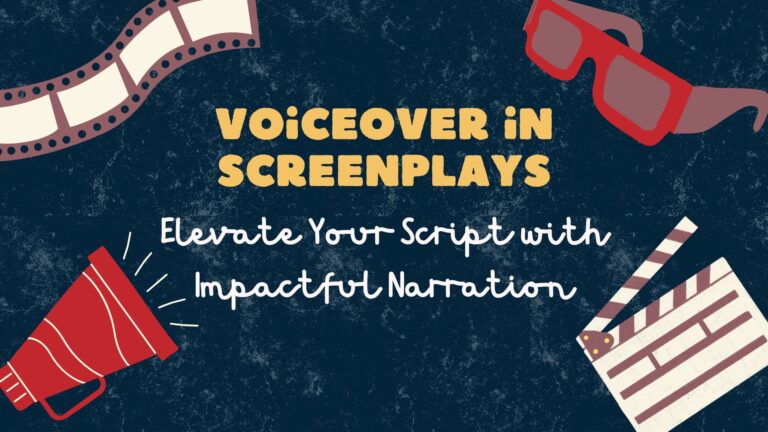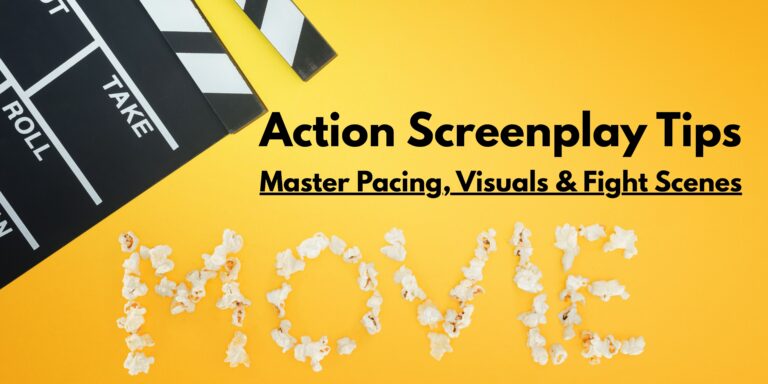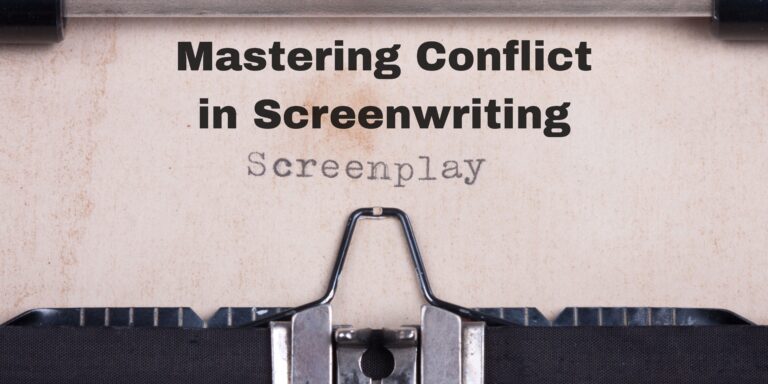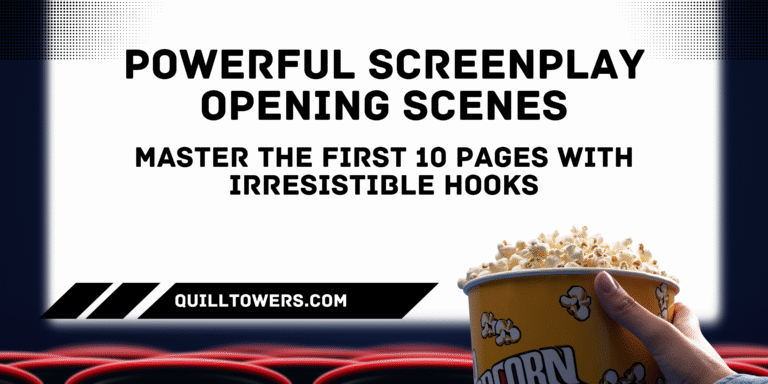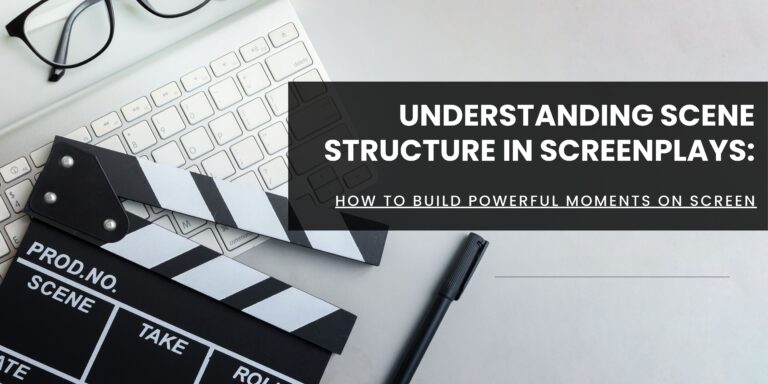Electrifying Screenplay Plot Twist Techniques: Surprise Without Losing Your Audience
“Wait! What just happened?” A screenplay plot twist is that exact moment when the audience gasps, leans forward, and realizes the story has just flipped on its head. It’s the thrilling lightning strike that turns an ordinary script into a legend, the exhilarating hidden trapdoor that drops everyone into an entirely new dimension.
But here’s the catch: modern audiences are sharp. They’ve streamed every mind-bending thriller, unraveled Christopher Nolan’s timelines, and memorized M. Night Shyamalan’s most fantastic reveals.
Creating a twist that doesn’t feel forced is a challenge, but if you nail it, your story won’t just shock; it will stick, remaining imprinted in their memory long after the film concludes.
Do you want to design twists that hit like thunder and keep viewers hooked till the last page?
Let’s get moving, this ride is about to twist!
What Makes a Screenplay Plot Twist Truly Electrifying?
There’s a reason filmmakers like Nolan, Shyamalan, and Fincher are almost synonymous with twists. They’ve mastered the art of shocking without breaking trust. At its core, a screenplay plot twist isn’t just about surprise; it’s about transformation. It completely changes the direction of a story, forcing both characters and viewers to recalibrate in real time.
Read more: Powerful Screenplay Opening Scenes: Master the First 10 Pages with Irresistible Hooks
Let’s clear the fog: not every surprise is a twist. Your car breaking down on the way to work? Annoying, yes, but not a plot twist. In storytelling, a twist is a deliberately constructed device that flips expectations while deepening meaning. It’s the cinematic equivalent of discovering that the house you thought you knew has secret rooms hidden behind the wallpaper.
A moment from Star Wars: The Empire Strikes Back. When Darth Vader drops the bombshell “I am your father”, it’s more than a reveal. It reframes the entire saga, turning a black-and-white battle between good and evil into a battlefield.
That’s the kind of twist that lingers because it ties directly into the story’s beating heart: family, legacy, and the fragile line between light and darkness.
The Anatomy of a Twist: From Capillaries to Core
A strong screenplay plot twist works like the human body, layered, interconnected, and alive.
Capillaries: Subtle Hints
Tiny veins of information run beneath the surface. A glance at a prop, a slip of the tongue, or a barely noticeable gesture. At first, they seem invisible, but when the twist lands, they rush into focus like hidden ink under a blacklight.
Nerves: Major Clues
These are bigger jolts, moments that make audiences squint and wonder, “Wait, what’s really going on here?” Sometimes, the truth is hinted at. Other times, we’re nudged in the exact wrong direction on purpose.
The Central Pillar: Character
Strip everything else away, and the twist must connect to the character. When someone we thought we knew is revealed to be entirely different, the emotional whiplash is unforgettable.
The audience doesn’t just gasp; they feel betrayed, heartbroken, or exhilarated because they cared deeply about the character. This anatomy ensures that when the twist finally hits, it doesn’t feel random. It feels inevitable.
Key Components of a Satisfying Plot Twist
Crafting a truly memorable screenplay plot twist isn’t just about shocking your audience; it’s about giving them a moment that feels inevitable in hindsight. See it like a well-set trap: the audience follows the story’s path, only to discover the snare was there all along.
A satisfying twist leaves viewers both amazed and convinced they should have seen it coming, even if they didn’t. With that in mind, let’s break down the key elements that make a twist land perfectly.
- Intentional Misdirection: The best twists aren’t accidents; they’re carefully planted seeds. A twist that appears out of thin air feels like a cheap magic trick. However, when misdirection serves a purpose, the audience feels both fooled and satisfied. Remember Obi-Wan’s infamous half-truth about Luke’s father? Technically, he wasn’t lying; Anakin Skywalker was destroyed when he became Darth Vader. This layered misdirection makes the eventual reveal cut even deeper. That’s misdirection with purpose, not manipulation.
- The Puzzle Approach: Crafting a screenplay plot twist is like designing a riddle. Every piece must fit together, even if the solution doesn’t emerge until the very last moment. Writers who love puzzles, riddles, and brainteasers often excel at twists because they understand one golden rule: the answer must be hidden in plain sight.
- Twisting Perception Through Irony: Irony is the skeleton key of a twist. It pits what characters know against what the audience knows, and sometimes, what neither knows. Take David Fincher’s Se7en. When Detective Mills screams, “What’s in the box?” the audience is struck by pure, brutal irony: the villain may be defeated, but his twisted philosophy has won. The result? A twist that doesn’t just shock but devastates.
Foreshadowing & Natural Payoff in a Screenplay Plot Twist
Ever sat in a theater, munching on popcorn, convinced you know exactly where the story is headed, only to be blindsided by a revelation that flips the script? That’s the beauty of a screenplay plot twist. It jolts the audience awake, but here’s the catch: it can’t feel like it dropped from the sky. For a twist to land, it must feel earned.
That’s where foreshadowing comes in. A twist without groundwork is like a magician revealing a rabbit from an empty hat; it sparks surprise, but no satisfaction. The best plot twists are less about smoke and mirrors and more about planting seeds early, then letting them blossom at just the right moment.
- Crafting Effective Plot Twists: A great screenplay plot twist doesn’t just appear out of nowhere; it grows organically from the story itself. Imagine it as a surprise bloom in a carefully tended garden: the seeds are planted early, nurtured, and finally revealed at just the right moment. To make your twist hit with maximum impact, you need to set the stage properly before the big reveal.
- Laying the Groundwork: A sturdy setup is non-negotiable. Build engaging characters with crystal-clear goals. Put your hero and villain on a collision course so when the twist arrives, it doesn’t feel random; it feels inevitable.
- Create Foreshadowing: Subtle hints make a screenplay plot twist feel natural. When the audience looks back, the signs should have been there all along, staring us in the face. In The Sixth Sense, Cole whispers, “I see dead people.” The line is more than a creepy flavor, it’s a breadcrumb that points straight to the shocking reveal that Dr. Crowe has been dead all along.
- Resonating with Emotion: A twist isn’t just about surprise, it’s about feeling. Think of Citizen Kane. When “Rosebud” is finally revealed as a childhood sled, the twist transforms Kane from an untouchable mogul into a tragic, lonely figure yearning for the innocence he once possessed. The audience doesn’t just understand him better; they ache for him.
The Golden Rule: Earn, Don’t Force
A forced twist is like a cheap fireworks show, loud, flashy, and instantly forgettable. A well-planted, well-executed twist, on the other hand, lingers for decades. One unforgettable surprise is more potent than a dozen half-baked reveals. Plant your clues, nurture your payoff, and let the audience reap the harvest at just the right time.
Character-Driven Screenplay Plot Twists: Rooted in Story, Not Just Shock
Here’s the truth: a screenplay plot twist that isn’t rooted in character is like a house built on sand; it collapses the moment you put it to the test. The strongest twists emerge organically from the inner lives of the characters, not from a writer’s whim to shock for the sake of shock.
Read more: How to Create a Compelling Character Arc That Drives Your Story Forward
When building your twist, ask yourself: If I were living in this story, how would I feel in this moment? That emotional compass should guide the setup, tone, and eventual payoff. In Jordan Peele’s Get Out, the eerie prologue makes it clear we’re in horror territory. Without it, the story might feel like a quirky rom-com until the twist breaks tone and leaves the audience feeling cheated.
- Motivations That Matter: At the beating heart of every great twist lies motivation. Characters aren’t chess pieces moved around for convenience; they’re human beings with desires, fears, and contradictions. Aligning a twist with those inner drives ensures the reveal feels natural, not contrived.
- Building Character Depth: Motivations are the DNA of your characters. They let the audience peer into what makes someone tick: ambition, love, jealousy, and fear. A twist that grows from this DNA resonates more deeply because it feels personal, not mechanical.
- Emotional Authenticity: When a screenplay’s plot twist is fueled by raw emotion, it has a greater impact. In stories where the revelation is tied directly to a character’s hidden truth or vulnerability, audiences don’t just gasp; they empathize. The surprise doesn’t hover on the surface; it sinks into the emotional core.
- The Dance of Surprise and Inevitability: The best twists make the audience say, “I didn’t see that coming… but I should have.” That’s the sweet spot. It’s the roller-coaster drop that makes your heart skip a bit while your brain races back through the story, connecting all the clues you missed.
So, avoid random surprises. Anchor your screenplay plot twist in who your characters are, what they want, and how far they’re willing to go.
When the revelation finally comes, it won’t just shock; it will redefine everything the audience thought they knew.

Types of Screenplay Plot Twists with Memorable Examples
A screenplay plot twist can strike at any point, halfway through to change the game or right at the end to reframe everything we thought we knew. Like a magician revealing a hidden card, it works best when it surprises the audience but still makes sense in hindsight.
Read more: Understanding Scene Structure in Screenplays: How to Build Powerful Moments on Screen
Peter Nowalk, creator of How to Get Away With Murder, nailed it when he said the secret lies in pacing: deciding which mysteries to introduce and when to reveal them. Too soon, and the punch fizzles. Too late, and the audience grows restless.
The sweet spot? A twist that both satisfies curiosity and sparks new questions.
Common Types of Screenplay Plot Twists
- The Red Herring: The story dangles an obvious suspect or solution, only to pull the rug away. In Harry Potter and the Prisoner of Azkaban, the narrative steers us toward believing Sirius Black is the villain, until the third act proves otherwise.
- The False Protagonist: Few moves shock harder than killing off the apparent lead. Scream (1996) did it brilliantly when Drew Barrymore’s Casey Becker, marketed as the film’s star, was killed in the opening scene. Talk about a curtain-drop moment.
- The Identity Swap: Characters Are Not Who We Thought They Were. The classic? The Empire Strikes Back. When Darth Vader declares, “I am your father,” it doesn’t just shift Luke’s perception; it shakes the foundation of the saga itself.
- Flashbacks and Flash-Forwards: Sometimes the twist lies in when the story is told. Lost was famous for this, with flashbacks that deepened character backstories and flash-forwards (like Jack’s post-island reveal) that recontextualized the entire narrative.
Legendary Screenplay Plot Twist Examples
Let’s revisit some unforgettable cases where twists didn’t just surprise, they defined the story.
- The Sixth Sense: Dr. Malcolm Crowe spends the film helping Cole cope with his visions, only to realize that he has been dead all along. A haunting reminder that the best twists are hiding in full view.
- Get Out: What begins as an awkward family visit spirals into horror when Chris discovers the family’s grotesque secret, using young Black bodies as vessels for ageing white minds. The revelation is both chilling and socially charged.
- Game of Thrones: When Ned Stark is executed in Season 1, the supposed protagonist vanishes, leaving viewers in shock. It proved that in Westeros, no one was safe, and the rules of traditional storytelling didn’t apply.
- Planet of the Apes: The sight of the Statue of Liberty buried in sand is a gut punch. The planet wasn’t alien after all; it was Earth’s grim future, one of cinema’s most iconic endings.
- The Others: Nicole Kidman’s Grace believes her house is haunted, only to discover she and her children are the ghosts. Told from her perspective, the revelation flips the world upside down.
- Tully: In this intimate dramedy, Charlize Theron’s Marlo leans on a free-spirited nanny named Tully, until we learn Tully is a figment of her imagination, a projection of her younger self. The twist reframes every scene with heartbreaking clarity.
- The Empire Strikes Back: Still worth repeating: when Vader tells Luke, “I am your father,” it doesn’t just shock, it reshapes the entire Star Wars saga. Few lines in cinema history have carried such cultural weight.
Why These Twists Work
Each example works not just because it shocks, but because it fits. These twists deepen themes, strengthen character arcs, and provide audiences with a reason to reflect long after the movie ends.
A screenplay plot twist that lingers redefines everything that came before while planting a seed that grows even after the story ends.
Screenplay Plot Twist Ideas to Spark Your Next Script
Is there anything more electrifying than a screenplay plot twist that knocks the wind out of you? Twists are the lightning bolts of storytelling; they make an audience wake up, ignite fresh excitement, and remind us why we fell in love with stories in the first place.
Whether in films, TV shows, or novels, a great twist can turn a predictable path into a roller-coaster ride.
Read more: 10 Screenwriting Mistakes to Avoid as a Beginner
But here’s the rub: while a brilliant screenplay plot twist delivers an unforgettable gut punch, a weak one leaves readers feeling duped, as if the rug was yanked out for no reason. That’s why twists can’t be your only magic trick. They’re fireworks, dazzling when lit at the right time, but meaningless without a solid foundation of character and story.
Think about it. We’ve all seen the familiar “hero vs. villain” showdown. But when the villain turns out to be the hero’s father, suddenly the floor collapses beneath us, and we love it. That’s the power of the right screenplay plot twist.
The good news? Crafting one doesn’t have to be rocket science. Start with a simple “What if…” and let that seed blossom into a revelation that changes everything. To get your creative juices flowing, here’s a collection of twist ideas you can weave into your script:
- The narrator isn’t who we thought they were.
- A weakness becomes the ultimate strength.
- The hero’s strength is what defeats them.
- The weakest character turns out to be the villain.
- The strongest character dies first.
- The smartest character is outwitted early.
- The hero is living a double life.
- The villain is secretly in love with the hero.
Timeline Twists
- The protagonist is revealed to be from the future.
- What appears to be the past is actually the present.
- The present is actually the future.
- An alternate reality sneaks in where we least expect it.
Mind-Bending Twists
- The story is actually a book written by the protagonist.
- Characters are figments of imagination.
- The antagonist is a split personality of the hero.
- A stranger reveals the world isn’t what it seems.
Supernatural Twists
- The protagonist’s soul is trapped in someone else’s body.
- Death, God, or Satan narrates the story.
- An angel serves as the unseen storyteller.
Tech & Sci-Fi Twists
- The events were all a computer simulation.
- The city is secretly inside a spaceship or mountain bunker.
- The “spaceship” is actually a prison.
- A drama morphs into full-blown science fiction.
These concepts aren’t just sparks, they’re fire-starters. Try them, twist them, and plant them into your story soil. If they fit, nurture them and watch your script grow into something unforgettable.

Crafting Twistable Worlds: Balance, Timing & Emotion
Every magician knows the trick is in the timing, and a screenplay plot twist works the same way. Too early, and the reveal fizzles. Too late, and the audience is already yawning. Hit it at just the right beat, though, and you’ve struck storytelling gold.
Timing is the pulse of suspense. Think of it as a dance, the audience follows the rhythm until, suddenly, the music shifts, and the floor drops beneath their feet. That’s when a screenplay plot twist becomes unforgettable.
Why Timing Matters
Even the most brilliant screenplay plot twist can fall flat if it’s revealed at the wrong moment. Timing is the lever that catapults a clever idea into a jaw-dropping experience. Like a perfectly choreographed dance, every twist needs to hit at just the right beat to keep the audience captivated, on edge, and emotionally invested.
- Crafting Suspense: Strategic timing builds anticipation. A well-placed twist keeps audiences perched on the edge of their seats, eyes wide, hearts racing.
- Subverting Expectations: A twist breaks the rhythm, preventing predictability. By flipping the script when least expected, you give your audience that exhilarating surprise.
- Maximizing Emotional Impact: Timing also determines the emotional weight. Shock, heartbreak, relief, whatever emotion you’re aiming for will only land if the twist strikes at the precise moment.
Read more: Script vs Screenplay: What’s the Real Difference
The secret sauce isn’t just about when you reveal the twist, but how it resonates with character arcs and themes. A great screenplay plot twist doesn’t just pull the rug out; it ties the carpet fibers back into the larger narrative of your story.
Bring Your Screenplay Plot Twist to Life: Start Writing Today
At the end of the day, the magic of a screenplay plot twist lies in its ability to both surprise and satisfy. You’ve now got a toolbox of ideas, from mind-benders to sci-fi stunners and the golden rule of timing to ensure your twist lands with impact.
So why should you care? Because your audience craves stories that not only entertain but also electrify. A well-executed screenplay plot twist doesn’t just keep eyes glued to the page; it etches your story into memory.
Now it’s your turn. Start experimenting, play with the “What ifs,” and dare to surprise your readers without losing them.
Contact Quilltowers today, and let’s create something extraordinary together.

